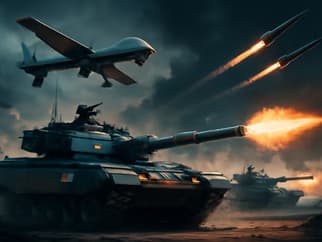India’s Growing Role in the Defense Sector

Remember the Republic Day parades we grew up watching? The sight of tanks rolling down Rajpath, fighter jets slicing the sky, and the loud applause echoing across living rooms captured the imagination of every Indian. Today, that patriotic thrill has transformed into a powerful investment theme, aligned with geopolitics, national security, and economic self-reliance.
Remember the Republic Day parades we grew up watching? The sight of tanks rolling down Rajpath, fighter jets slicing the sky, and the loud applause echoing across living rooms captured the imagination of every Indian. Today, that patriotic thrill has transformed into a powerful investment theme, aligned with geopolitics, national security, and economic self-reliance.
With rising geopolitical tensions, a massive ₹6.2 lakh crore defense budget for FY25, and a strong push for "Atmanirbhar Bharat" (Self-reliance), India’s defense sector is rapidly evolving. It’s shifting from being a buyer of defense equipment to a builder, and soon, a global exporter.
A Global Snapshot of the Defense Industry
The global defense market stands at $2.1 trillion in 2024, with the U.S. leading the charge, followed by China, Russia, and India. As military strategies evolve, there is a growing emphasis on smart warfare systems, including AI, drones, and hypersonic missiles. Emerging economies, including India, are rapidly increasing their defense budgets to modernize military capabilities and address regional threats.
India's Defense Budget and Growth
India’s defense budget for FY25 stands at ₹6.2 lakh crore (~$74 billion), marking a 4.8% increase. While India spends approximately 2.5% of its GDP on defense, it is still lower than Russia and Saudi Arabia. However, with a focus on indigenous manufacturing, India’s defence industry was valued at $17.2 billion in 2024 and is expected to grow to $28.4 billion by 2033, driven by advancements in weapons, cyber, and surveillance technologies. Defence production hit a record ~$16.3 billion in FY 2023–24, with exports rising to ~$2.85 billion in FY 2024–25. The government aims to boost domestic manufacturing to ~$34.7 billion)by FY 2028–29.
Global Defense Spending (% of GDP) in 2024:
- USA: 3.5%
- Russia: 7.1%
- India: 2.5%
- USA: 3.5%
- Russia: 7.1%
- China: ~1.8%
- India: 2.5%
- Germany: 1.9%
- France: 2.1%
- Pakistan: 1.7%
India’s moderate defense spending, given its vast population and other priorities, is expected to increase as national security concerns intensify.
From Importer to a Defense Exporter
Historically, the world’s second-largest defense importer, India, is now focusing on boosting indigenous manufacturing. Defense exports reached ₹23,622 crore (~$2.76 billion) in FY25, with a target of ₹50,000 crore by 2029. Key exports include missiles, radars, and surveillance systems, with countries like Armenia, Vietnam, and African nations becoming major markets.
India’s defense industry is also becoming a key supplier for countries like the U.S. and France, supplying components for military platforms like the Apache helicopter and C-130J aircraft.
Global Import and Export Trends
Despite a significant reduction in arms imports, India remains the world’s second-largest importer of defense equipment. However, it is making substantial strides in boosting domestic manufacturing and defense exports, which touched ₹23,622 crore (~$2.76 billion) in FY25, marking a 12% increase year-over-year.
India’s Defense Export Strategy:
- India’s defense exports surged from ₹686 crore in 2013-14 to ₹23,622 crore in 2024-25, with private sector exports at ₹15,233 crore and DPSUs at ₹8,389 crore, reflecting a 42.85% growth in DPSU exports.
- Export authorizations rose by 16.92%, and India exports to around 80 countries, aiming for ₹50,000 crore in exports by 2029, bolstering its global defense manufacturing presence.
- India’s defense exports include missiles, radars, patrol boats, artillery, and surveillance systems, with key markets including Armenia, Vietnam, Mauritius, and African countries.
R&D and Technological Advancements
India is heavily investing in R&D to enhance its defense capabilities. The DRDO is leading the charge with developments in hypersonic missile systems, stealth aircraft, and AI-powered surveillance tools. The AMCA (Advanced Medium Combat Aircraft) program and India’s successful testing of hypersonic missiles are solidifying the country’s position as a technological powerhouse in defense.
Manufacturing and Government Initiatives for Self-Reliance in Defense
With an emphasis on "Atmanirbhar Bharat," India is advancing its defense manufacturing capabilities. HAL is producing Tejas fighter jets, while Indian shipyards are constructing destroyers and frigates, including the INS Vikrant, the first indigenous aircraft carrier. Manufacturing value hit ₹1.27 lakh crore in FY24, a nearly 2.5x increase since FY15.
To further enhance defense manufacturing, India has set up two specialized defense industrial corridors in Uttar Pradesh and Tamil Nadu. These corridors are designed to attract investment, boost domestic production, and foster innovation. The government’s positive indigenization list, which includes over 4,666 items, is another step toward reducing dependence on foreign technology.
Key Initiatives:
- Atmanirbhar Bharat Abhiyan: Encourages self-reliance in defense manufacturing.
- Defense Production and Export Promotion Policy (DPEPP): Aims for USD 25 billion in defense production and USD 5 billion in exports by 2025.
- Defence Industrial Corridors: Two corridors are being developed to attract investment and accelerate defense manufacturing.
- Indigenous Procurement: New platforms like Make-1, Make-2, and IDDM are creating demand pipelines. These initiatives are complemented by global conflicts such as the Russia-Ukraine war, which have prompted countries to diversify their defense sourcing, creating an opportunity for India to step in with competitive pricing and scale.
India-Pakistan Conflict: Geopolitical Catalyst for Defense Growth
The ongoing tensions between India and Pakistan have acted as a catalyst for India's defense strategy. With Pakistan's defense spending on the rise, India’s defense allocation is likely to increase in the coming years. The conflict has also accelerated India's focus on advanced systems like drones and missile defense, areas where India is striving to gain a technological edge.
Impact of the Conflict:
- Increased Defense Spending: Likely rise in defense allocations to address security concerns.
- Export Opportunities: India could benefit from heightened global demand for defense systems due to geopolitical instability.
- Technological Growth: Focus on drones and AI for surveillance, crucial for modern warfare.
India’s defense industry is undergoing a major transformation. From being a major arms importer, the country is shifting toward manufacturing and exporting defense equipment. With a robust focus on indigenous production, technological advancements, and strategic partnerships, India is positioning itself as a global defense power. The rise of defense exports, coupled with advancements in R&D and manufacturing, signals a bright future for India’s defense industry on the global stage.
Challenges and Strategic Vision:
Despite these advances, challenges remain. India still relies on foreign technologies for advanced systems like stealth tech and engines. Additionally, long procurement cycles and bureaucratic red tape slow down progress. However, with strategic vision and ongoing reforms, India aims to reduce defense imports to under 30% by 2030 and become one of the top 5 defense exporters by 2047.


_1755606872650.png&w=3840&q=75)


